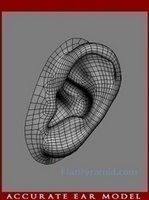Four Methods of 3D Modeling
3D modeling is the process of mathematical representation of any three-dimensional object. The main objective of 3D modeling is creating a visual image of the object. The model is usually based on real life objects (for example, cars, buildings, or humans), but it can also be fully abstract — fractals, graphics and so on.
3D graphic is often used in construction building, industrial and architectural visualization, systems of medical visualization and so on. Nowadays 3D modeling is more than popular in cinematography, TV production, and computer games development.
Creation of 3D model is a complex process. And it’s clear, that different objects need different techniques to use them in virtual reality. Let’s find out, what are the most common ways and methods to create your 3D model of any object.
3D modeling techniques: types and features
Polygonal modeling
Polygonal modeling is based on manipulations with object grid on the level of its parts: vertices, edges and faces. And this method of 3D visualization allows to create any form of the object because of large variations of polygons combinations.
Polygonal modeling is one of the main types of 3D visualization. It’s easier than the other methods and can be used for creating 3D models of anything except maybe living creatures.
There are 3 levels of polygonal modeling:
- Low-polygonal modeling (low-poly) is designed to create objects with a smaller number of polygons, usually to save resources, when high detailing is not required, as well as to create low-poly illustrations that are gaining popularity in recent times;
- Medium-polygonal modeling (mid-poly) is usually oriented only on the necessary result in rendering or modeling the desired geometry, for example, using Boolean operations. There is usually no optimization for mid-poly or it is minimal;
- High-polygonal modeling (high-poly) is the creation of an object with a larger number of polygons, usually an exact copy of it.
Polygonal model consists of huge amount of triangles, rectangles and other forms of simple figures. But smoothing plugins cover all the angles, so model is perceived as a holistic object.
The standard scheme of high-poly modeling occurs with a gradual increase in the level of detail of the 3D object:
- The first level is basic, and represents the general form of the object.
- At the second level, the basic form is refined, usually by adding chamfers.
- The third level is the final one, it makes a detailed object specification, usually by applying smoothing plug-ins.
Polygonal modeling is perfect tool to create 3D visualizations for buildings or industrial instrument. But there are other methods which have to be mentioned. So let’s move on.
Spline modeling
Spline modeling is a creation of 3D objects using curves (splines). Splines can serve lines of various shapes: circles, rectangles, arcs, etc. Objects in this case are obtained in a smooth form, so this method is widely used in the creation of organic models, such as plants, humans, animals, etc.
The advantage of this method is in a flexibility of changing the shape of the spline.
This type of simulation is often compared to polygonal, as vector graphics with raster. The advantage of vector graphics is that when the object is enlarged, its quality does not change, unlike the bitmap, where pixels become visible. Similarly, when an object created by splines is enlarged, its quality will remain unchanged, and polygons will be visible when polygon modeling is performed.
Spline modeling is usually used for creating models with rounded shapes without strict angles. Cars, for example.
NURBS modeling
NURBS stands for ‘Non-Uniform Rational B-Spline’, and is a technology for creating 3D objects using special curves called B-splines. Some experts distinguish this type of modeling as a separate, and some — in a subset of spline modeling.
The principle of modeling is as follows: using B-splines arranged vertically and horizontally, the desired shape of the object is constructed, and then connected using polygons.
There are two types of this modeling:
- using P-curves (Point), whose shape can be changed with the help of vertices, which are located directly on the line itself;
- using CV-curves (Control Vertex), the shape of which can be changed using vertices that are located outside the line.
3D-sculpting
3D-sculpting or a ‘digital sculpture’ is an imitation of the process of ‘molding’ the 3D model, that is, deformation of its polygonal mesh with special tools — brushes. You can draw an analogy with sculpting figures with hands, made of Plasticine or clay. But in the 3D modeling programs fingers are replaced with the ‘brush’ tool, and the ‘Plasticine’ is a polygonal mesh.
This method is usually used in movies production and computer games creation, because of high quality and specification of models. But usage of this method needs some high skills of sculpturing. It is more than effective, but it’s really hard to work with.
Conclusions
Thus, we can draw the following conclusion. When creating models that are not complex shapes, it is better to use polygonal modeling. To obtain a smooth form of simple objects — spline or NURBS modeling, or polygonal with the use of smoothing tools.
Creating complex biological organisms, it is more convenient to use 3D sculpting. When it is necessary to create an accurate model with the necessary gaps and taking into account the physical properties of the material, then the methods of industrial modeling are most suitable here.
And creating complex models, the above modeling methods are often used together, as this speeds up the modeling process. And their mix can be called as advanced 3D modeling techniques. So, for example, when creating a character for games, 3D sculpting is used, with which necessary small details are drawn, and then on its basis a low-poly model is created with polygonal modeling.

